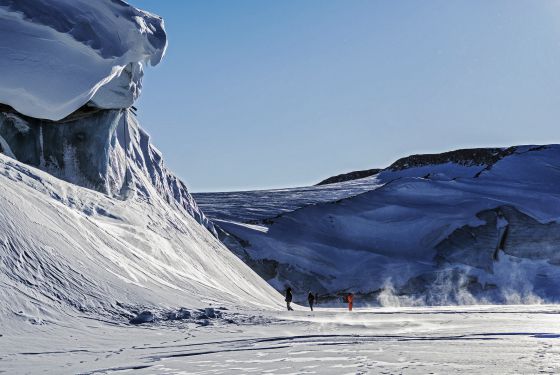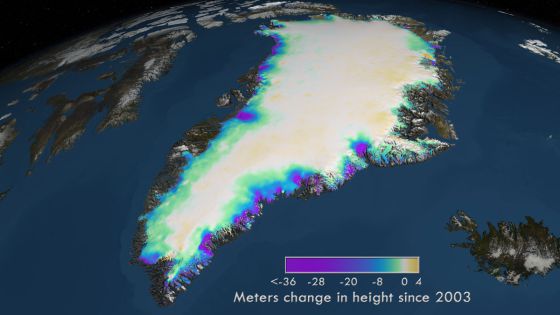
Scientists Operation IceBridge this summer, facing the wall of ice that is the glacier front Great Land. NASA / Michael Studinger
The giant bucket of ice covering most of Greenland, with nearly five times the size of Spain, is melting at an accelerating rate. Study shows its icy mass lost as many cubic kilometers, once soggy, filling 110 million Olympic swimming pools every year and so from 20 ago.
Greenland is, after Antarctica, the largest reserve fresh water on the planet. It has been estimated that if all the ice covering the large northern island suddenly melted, sea level over six meters would rise. It would not be so fast, but a group of American and European researchers have conducted the largest estimate of the evolution of glaciers made to date and the results are overwhelming.
So far, estimates of the ice cap Greenland is based on developments in four of its major glaciers, each dying in a cardinal point of the island. The thickness, changes in altitude, rate of progress towards the sea and melting of these rivers in slow motion was then extrapolated to the entire ice sheet. The problem is that on the island there are at least 242 large glaciers, each with its own evolution
.
The study altitude data used 100,000 points of the island obtained by laser altimetry
To follow the dynamics of glaciers, scientists have used data from two complementary NASA missions. On the one hand, within its ICESat program, completed in 2009, laser altimetry system calculated the height of the ice with each step performed on the island. For completeness, a plane of Operation IceBridge, also used light pulses for measuring its bounce, determine the height of the ice. Combined, the two missions mapped the island at 100,000 points. The records begin in 1993, which has enabled researchers to check the drift of the glaciers every year.
The Greenland ice sheet has lost, on average, about 243,000 million metric tons every year since 20. In volume ago, this huge mass occupy about 277 cubic kilometers. What is worse, as published in the journal PNAS , this dynamic thinning is accelerating in recent years.
“The dynamic thinning is due to the acceleration of glaciers “says professor of geology at the University of Buffalo (USA) and lead author of the research, Beata Csatho. “As the speed increases, more ice reaches the sea, causing the glacier thin. It’s like you will stretch gum” he adds. This stretch, which implies a lower concentration of the ice mass, makes it more vulnerable to the action of temperature or sea water.
The study shows that 48% of net mass loss Ice is due to the acceleration of the movement of glaciers. And nearly half of which occurred in the southeast of the island. The other 52% of the melting of Greenland is due to the reduction in snowfall and snowmelt caused by global warming both home
.

The greatest reduction in the height of glaciers (in purple) has occurred in the southeast of the island. NASA’s Goddard Space Flight Center
The environmental importance of glaciers is much higher than the melting Arctic called. The polar cap has an annual cycle of freezing and thawing of the ocean. While the extent of sea ice is becoming less year than last, its impact on sea level would be zero. “The sea ice is formed from ocean water frozen so that variations in sea ice have no direct impact on sea level rise, in the same way that an ice does not raise the water level glass, “recalls Csatho
.
Greenland Melting sea level rises 0.68 mm per year
But the melting of glaciers does provide a net amount of water to the sea. He estimates that since 1993, the Greenland ice water would become elevated sea level at about 0.68 millimeters each year. Furthermore, the two types of reinforcing melt. “The reduction of sea ice has an impact on the global climate changing ocean circulation and allowing the ocean surface absorb more solar radiation and thus raising the temperature of the Arctic,” recalls the American researcher.
This increase in temperature in devilish combination accelerates the melting of the ice mass of the island and the descent of glaciers. Nor is negligible reduction in albedo effect, the ability to bounce ice much of the solar radiation.
But to put things in perspective, remember that there is still a lot of ice in Greenland. If you have lost about 277 km 3 , there are still 2.8 million km 3 . The problem is that the melting of polar ice could accelerate further that could reach a point of no return. As Csatho says: “Some studies predict irreversible changes in Greenland a few centuries or even before Our results will help improve models of the ice to give a better answer to this question.”
In the news
- Study: ‘ Laser altimetry Reveals complex pattern of Greenland Ice Sheet dynamics’
No comments:
Post a Comment